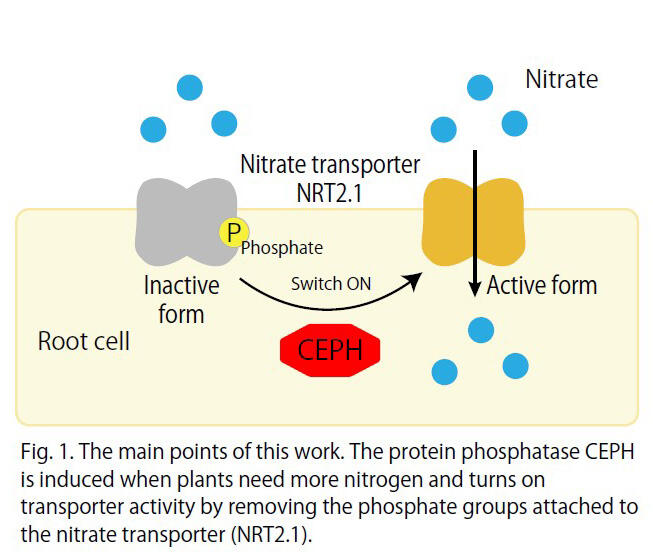A research group led by Professor Yoshikatsu Matsubayashi and graduate student Yuri Okubo, Graduate School of Science, Nagoya University, and designated lecturer Keiko Kuwata, Institute of Transformative Bio-Molecules, Nagoya University (ITbM), has announced the discovery of CEPH, the enzyme that switches on the nitrogen transporters involved in the uptake of nitrogen by plant roots. They searched for the gene that are induced when the hormone gene responsible for promoting nitrogen absorption moving from the leaf to the root of the Arabidopsis thaliana is overexpressed. It was found that CEPH switches the nitrogen ion transporter from inactive to active. The team established that plants with more of the enzyme than usual had more ability to absorb nitrogen. It is hoped the findings will contribute to the discovery of mechanisms by which plants adapt to the environment and to increased agricultural production. The research was published in the online edition of Nature Plants, the British science journal.

The nitrate transporting protein NRT2.1 mediates uptake of nitrogen from the roots of plants in response to environmental conditions and nitrogen demand from the plant itself, in the form of nitrate ions. The team found that nitrate ion transporters are switched off by phosphorylation modification. They are switched on when the phosphate group is removed. However, the dephosphorylating enzyme (the protein-dephosphorylating enzyme) was not known.
Previously, the research group discovered that the hormones that promote uptake of nitrate ions moving from leaves to roots were CEPD and CEPD2, and that these hormones increased expression of nitrate ion transporting genes in roots.
In this study, using Arabidopsis, the research group sought the gene that is strongly induced in the root of the plant where the hormone is overexpressed. They found a gene that is more strongly induced than the nitrate ion transporter gene. It was designated CEPH (CEPD-induced phosphatase) as it is thought to dephosphorylate the CEPD gene sequence and works to induce hormone-dependent expression in roots during nitrogen starvation.
Then, in order to analyse the function of the gene, a CEPH-deficient Arabidopsis plant was created and observed. Compared to a wild specimen, the CEPH-deficient plant displayed more symptoms of nitrogen starvation. The CEPH-deficient plant had smaller above-ground part, yellow coloration and about 40% less nitrate in its leaves and roots than its wild counterpart. When the CEPH gene was introduced to the deficient specimen, they established that the volume of nitrate in the leaves and roots returned to the level seen in the wild plant. In fact, where CEPH was well expressed, nitrate uptake activity increased.
In the exhaustive search for the target of CEPH, the group discovered it to be the 501st serine of the nitrate ion derivative. At the same time, a French research group reported the function of the 501st serine of the nitrate ion transporter. In light of both findings, the researchers ascertained that CEPH was the enzyme that dephosphorylated the nitrate ion transporter, thus switching it from inactive to active.
It is likely that plants synthesize a surplus of nitrate ion transporters when nitrogen is plentiful, keeping some inactive transporters in stock. They then induce and activate CEPH in response to the need for nitrogen when it is deficient. As an enzyme, CEPH can probably increase the uptake of nitrogen by efficiently activating nitrate ion transporters, because it can activate hundreds of times the number of the transporters with a single molecule.
Matsubayashi states that, "We hope to apply these findings to foundational technologies so that more crops can be produced with less fertilizer, either by increasing the action of the CEPH gene or by selecting strains with a strong CEPH gene function."
This article has been translated by JST with permission from The Science News Ltd.(https://sci-news.co.jp/). Unauthorized reproduction of the article and photographs is prohibited.




